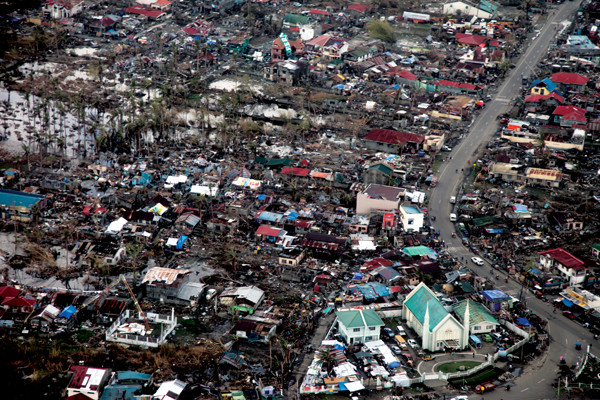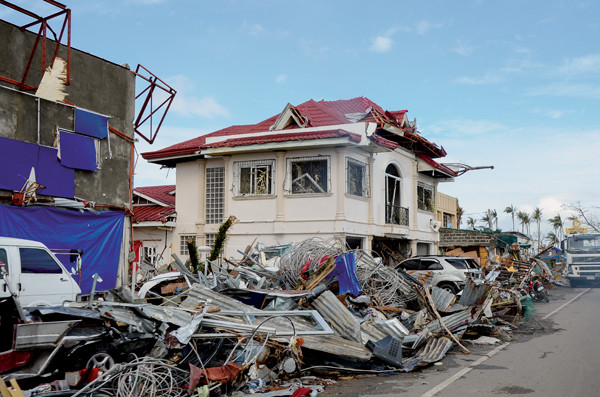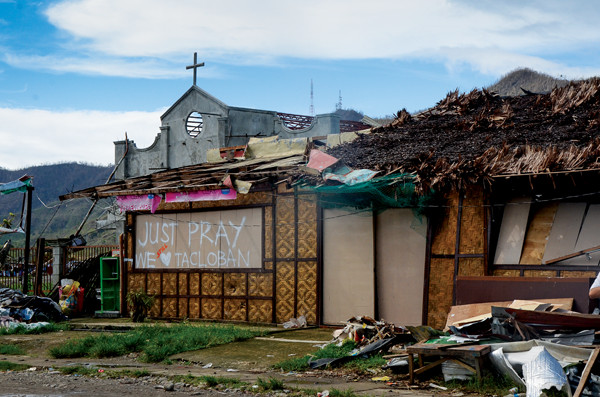
by Emma Scanlon and Walter D. Mooney Sunday, October 5, 2014
On the morning of Nov. 8, 2013, Super-Typhoon Haiyan struck the east-central Philippines with sustained wind speeds exceeding 300 kilometers per hour. In a mere eight hours, the storm cut a path of total devastation over an area of 300 square kilometers, an area roughly the size of Seattle. More than 7,800 people were confirmed dead or missing and 27,000 injured; more than 4 million were displaced from their homes. Economic losses to homes, infrastructure and agriculture reached more than $12 billion (U.S.).
A typhoon is a warm-core tropical cyclone spawned west of the international dateline. A “super-typhoon,” as defined by the U.S. Joint Typhoon Warning Center, is one that reaches maximum sustained one-minute surface winds of at least 240 kilometers per hour, the equivalent of a Saffir-Simpson Category-4 or Category-5 Atlantic hurricane.
Tropical typhoons can be tracked from birth to landfall, meaning days of advance warning can be provided to those in a storm’s path. So why were the human and economic losses of Super-Typhoon Haiyan so great? A field assessment conducted in the Philippines from Nov. 18–25, 2013, by one of us (Emma Scanlon) provides insight into this question.
Super-Typhoon Haiyan — or Yolanda as it is known in the Philippines — first made landfall at 4:40 a.m. local time in Guiuan, a city of roughly 47,000 people situated at the southern tip of the island of Eastern Samar in the east-central section of the Philippine Islands. In Guiuan, as in many cities in the Philippines, the predominant building materials are wood and sheet metal, with reinforced concrete structures comprising a small fraction of buildings. Super-Typhoon Haiyan destroyed more than 90 percent of the buildings in Guiuan. Record-setting wind speeds were not the only destructive force. The accompanying storm surge reached a height of 5 to 6 meters, causing numerous drownings. Some 2,000 people lost their lives in the southern portion of Eastern Samar, and nearly the entire population lost their homes. Even reinforced concrete buildings suffered major damage as many roofs collapsed.
The storm then struck Tacloban, a city of 200,000 people on the island of Leyte located 160 kilometers west of Guiuan, at full force at 7 a.m., with the same record-setting wind speeds and high storm surge as experienced in Guiuan. The destruction of Tacloban, much of which is less than 3 meters above sea level, was widely reported by international media because it became accessible when its airport partially reopened several days after the typhoon struck. More than 3,000 people died from drowning and blunt-force injuries caused by heavy objects carried by the wind and sea. Buildings constructed mainly of cinder blocks, wood frame and bamboo were destroyed. Reinforced concrete buildings fared better, though they still lost windows and roofs.
Next in the path of destruction was the city of Bogo, with a population of 70,000, on the northern tip of the island of Cebu. By then, Haiyan’s fury had diminished somewhat and thus damage in Bogo was less intense. Nevertheless, numerous structures were destroyed, and power and communication lines were downed. Inspection of a damaged bus terminal building showed that the roof had completely collapsed into the center of the building.

Super-Typhoon Haiyan unleashed a storm surge up to 5 meters high on the island of Leyte in the Philippines; elevations in some areas of the island capital, Tacloban, are less than 3 meters above sea level. Credit: U.K. Department for International Development.
Conversations with local residents indicated that many people underestimated the level of risk posed by Super-Typhoon Haiyan. The people felt that they were familiar with tropical typhoons, but they had never experienced such enormous wind speeds. Furthermore, interviews with the public and government officials revealed that there was considerable confusion regarding the term “storm surge.”"
On Nov. 6, 2013, a nationwide warning was issued by Project NOAH (Nationwide Operational Assessment of Hazards), a Philippine government weather monitoring group attached to the Department of Science and Technology. Mahar Lagmay, who heads Project NOAH, told our U.S. Geological Survey team that a warning was issued advising the public that “the water will rise by up to 5 meters in some areas.” Despite this warning, local governments did not require people in the low-lying and coastal areas to evacuate.

In many cities in the Philippines, the predominant building materials are wood and sheet metal. Reinforced concrete structures, which fared better in the storm, comprise only a small fraction of the buildings. Credit: USGS/Emma Scanlon.
“n the aftermath of the deadly typhoon, many people stated that they were not properly warned of the impending catastrophe. Conversations with Professor Lagmay shed light on some interesting quotes from Ta"loban City Councilor Cristina Gonzales-Romualdez and University of the Philippines professor Raquel Fortun that appeared in local Philippine print media. It appears that part of the problem lies in the wording of the warning that was issued, which caused confusion for both local governments and the public. In the announcement, Project NOAH warned of a “storm surge,” a term that is unfamiliar to the Philippine public. The term “tsunami,” however, is better known.
“We were warned about a storm sur"e, but we were not w"rned about a tsunami,” reported Gonzales-Romualdez, who survived the typhoon along with her husband, Mayor Alfred Romualdez, and their two daughters. “We didn’t even know that a tsunami can be caused by a storm. Did it ever happen in the past?” she asked.
Lagmay noted that using the word “tsunami” instead of “storm surge” in the advisory might have encouraged people in the coastal areas to flee for safety, but he added that it would have been a scientifically inaccurate description. A tsunami is caused by a sudden displacement of water in the ocean due to an earthquake, landslide or submarine slump; a storm surge is a rise in the coastal water level due to wind shear at the ocean surface.

The typhoon struck Tacloban, a city of 200,000 people, at 7 a.m. on Nov. 8 with record-setting wind speeds and a high storm surge, killing 3,000 people in that city alone. Credit: USGS/Emma Scanlon.
In the wake of the devastation caused by Super-Typhoon Haiyan, use of “storm surge” has also caused concern in academia. Professor Fortun publicly questioned use of the term storm surge, saying that a more familiar term, such as “tidal wave,” should have been used instead.”
The experience in the Philippines is just the most recent example of how the choice of specific words in a warning advisory can affect public response. As described in an article in the October 2013 issue of EARTH (“A Hurricane by Any Other Name: How Sandy Changed the Way We Issue Storm Warnings”), Hurricane Sandy was downgraded from a hurricane to a post-tropical storm prior to its arrival in the northeastern U.S. in October 2012. This may have prompted some people to ignore warnings about the potential severity of the storm.
Natural disasters and emergency situations in which thousands of lives are at stake call for extraordinary efforts to adequately warn the public of danger, perhaps even the invention and use of terminology — such as “tsunami-like storm surge” or “hurricane-force storm” — that may not be scientifically accurate.
Super-Typhoon Haiyan and Hurricane Sandy, which occurred more than 10,000 kilometers apart in countries with vastly different economies, have provided the same lesson: We need to communicate risk to the public in clear and unambiguous terms. Warning systems for natural disasters have advanced greatly during the past decade, but the last mile — communicating the risk to the public — may be the most challenging part of the journey.
© 2008-2021. All rights reserved. Any copying, redistribution or retransmission of any of the contents of this service without the expressed written permission of the American Geosciences Institute is expressly prohibited. Click here for all copyright requests.